Competitive Monitoring: How to Stay On Top of Your Competitor’s Every Move
Learn how to conduct effective competitive monitoring to stay on top of your competitors' every move and adjust your strategies whenever needed.


If you want to stay relevant and ahead of the curve in your industry, you need to implement a competitive monitoring strategy.
Knowing what your competitors are up to, what kinds of content they’re posting, how their online strategy is performing, and what their audience likes to see from them should be an essential part of your process.
Read along with us as we introduce you to what competitive monitoring means, how it will give you an advantage, plus eight essential strategies you can put in place to keep an eye on the competition.
Key takeaways
-
Track website changes and content updates: Set up alerts and use change-tracking tools to catch competitors’ new pages, pricing updates, or product announcements.
-
Gather social media intelligence: Benchmark competitors’ top-performing content and engagement rates to refine your own posting strategy.
-
Monitor customer perception: Analyze reviews and comments on competitors’ profiles to uncover pain points and unmet needs.
-
Anlyze brand messaging and positioning: Audit how competitors frame their value proposition across channels to identify gaps or opportunities in your messaging.
-
Keep an eye on product and feature development: Track product updates and changelogs to anticipate upcoming launches and adjust your roadmap accordingly.
-
Oversee market expansion and different channel strategies: Monitor new platforms or regions where competitors are gaining traction to spot untapped growth areas.
-
Don't neglect organizational changes: Watch for leadership hires, team expansions, or funding news that could signal a shift in strategy or focus.
Competitive monitoring is the practice of monitoring your competitors and their activity. This includes things like their social media posts, digital ad campaigns, product launches, price changes, and more.
To get a better understanding of what exactly competitive monitoring looks like—as well as what it doesn’t entail—read through the table below.
How does monitoring fit into your broader competitive intelligence ecosystem?
Having an overarching competitive intelligence strategy means you’re putting competitive monitoring, analysis, and benchmarking altogether in a single comprehensive plan or process. Monitoring is often one of the first steps in competitive intelligence, as it’s where you start to collect your information.
From there, you can analyze what you’ve found through your monitoring strategy and discover benchmarks you should be meeting. All in all, not much competitive intelligence can be gained if you’re not properly monitoring the landscape.
How does competitive monitoring help businesses gain a competitive advantage?
Competitive monitoring is an ongoing process that helps businesses keep an eye on what’s going on across their industry. There are a number of benefits to monitoring your competitors that can give you an advantage.
Early warning system
Detect competitive threats before they fully materialize, giving you time to prepare strategic responses rather than reacting after the fact. For example, you can get a heads up when your competitors are launching a new product, service, or feature so you’re aware of changes across the landscape.
Strategic opportunity identification
Spot gaps in competitor offerings, messaging shifts, or market positioning changes that create openings for your business. If you can solve customer problems that your competitors aren’t or if you can find a target market that your competitors are neglecting, it opens a huge opportunity for your business.
Informed decision-making
Base strategic decisions on real-time competitive intelligence rather than outdated assumptions or guesswork. Monitoring gives you real, tangible data and insights on your competitors. This helps you make better decisions because you have actual information to go off of.
Proactive messaging adaptation
Adjust your messaging and positioning in response to competitor communication shifts before they gain traction. Being able to stay one step ahead of the competition is a superpower that can really boost your business.
Faster market response
Reduce the time between competitor actions and your strategic responses through systematic monitoring and established protocols. Always have your thumb on competitor movement so you can swiftly pivot, adjust, and respond.
Essential competitive monitoring strategies to stay ahead of the curve
Ready to start monitoring your competitors and industry so you can stay in-the-know? These eight strategies can help.
Digital presence and content monitoring
First things first, let’s talk about monitoring your competitors’ digital presences and online content across their website and other channels. This provides you with insights like:
- What types of content they’re publishing.
- How their website is performing.
There are four main tactics you can employ to help you track your competition’s digital presence, website, and content.
Setting up effective Google Alerts to track competitor mentions

To make sure you don’t miss a single mention, set up alerts for things like:
Each competitor’s business name
Relevant products to your industry
Proprietary product, service, or feature names your competitors use
Other key terms or phrases that people use when talking about your competitors or industry
You can then set how often you want to be alerted, whether you want alerts as they’re published, a daily digest, or a weekly digest.
Tools and techniques for tracking website changes and content updates
SEO tools like Ahrefs and Semrush are imperative for tracking your competition’s website performance. You can look at keyword and backlink data (which we talk more about next) as well as track website changes and content updates.
Keep an eye out for major website changes like design updates, new webpages, or changes in content topics that might alert you to upcoming company updates.
Monitoring backlink acquisition to identify partnership strategies
Your SEO tools can also help you monitor your competitors’ backlinks (the websites that link to your competitor websites) and find opportunities for your business to boost its backlinks as well.
Ahrefs specifically has a “Link Intersect” tool that lets you see all of the websites that link to your competitors but don’t link to you. Pull that list of websites and start reaching out to them to see if there are any opportunities to partner up.
Tracking keyword rankings to detect SEO strategy shifts
SEO tools can also provide you with data like:
- The keywords your competitors are currently ranking for.
- New keywords they’ve started ranking for.
- Keywords they’ve lost rankings for.
Pay attention to keyword movement as it can let you know if your competitors are adjusting their SEO strategies, targeting new markets, or widening the net of topics they cover. This can give you insight into upcoming movements in their overall product strategy.
Social media intelligence gathering
Monitoring your competitors’ social media platforms can also provide you with amazing insights into their marketing messaging, target audiences, positioning, and more. Use these tactics to help you gain competitive intelligence through their social media presence.
Observing brand identity, engagement tactics, and audience growth
Start by observing each competitor’s visual brand identity, the way(s) they engage with their audience, and how, in turn, their audience seems to grow.
Let’s walk through each one while using a real-life example. Odd Muse is a luxury womenswear brand. One of their competitors is online women’s fashion brand Oh Polly. Let’s look at how Odd Muse would handle social media intelligence gathering across Oh Polly’s presence.
Visual style
Odd Muse has a minimalist, elegant, and luxury-inspired style that seamlessly comes through across its social media channels.
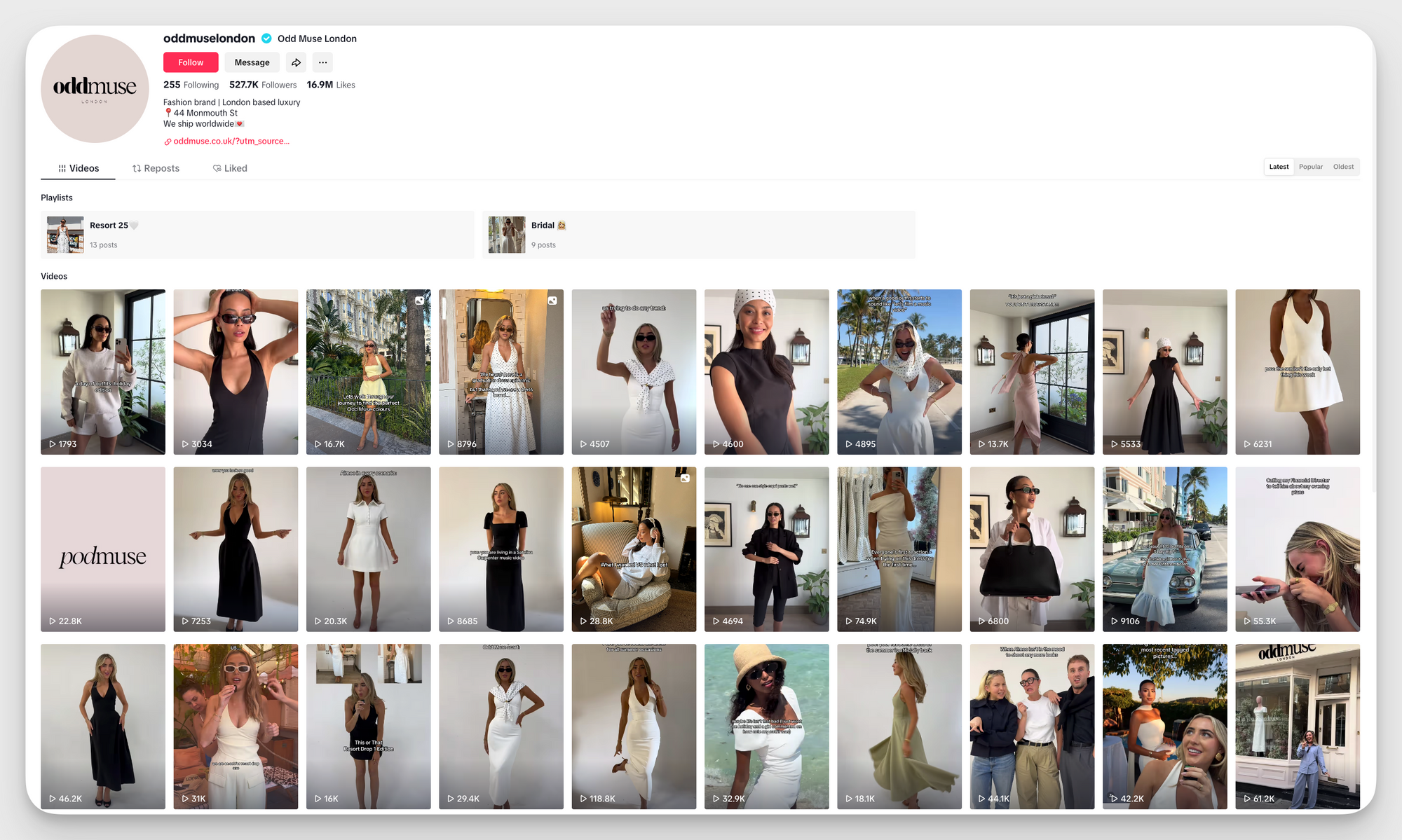
In contrast, we can see that Oh Polly veers towards a bolder, more glamorous and trend-driven style.

Engagement tactics
Next, you want to look at engagement tactics and see how your competitors tend to interact with their followers.
At Odd Muse, their founder is the face of their brand, appearing frequently in videos and hosting the brand’s new podcast, which adds authenticity and relatability to the brand. When their founder is the center of their content, it makes their audience feel like they’re connecting with an actual person rather than a brand.
With this in mind, Odd Muse takes a more storytelling approach to their content, using a “luxury for less” narrative that their followers love. The brand also partners with micro-influencers and organic community creators to further boost engagement across their target audience.
On the other hand, Oh Polly relies more on models and influencers than using someone from their team as the brand’s representative. Instead of slower engagement tactics like storytelling, Oh Polly leans on trend hijacking, TikTok challenges, and shock-value cuts.
The brand also uses much larger influencers than Odd Muse, especially in beauty/fashion, as well as professional models, creating a stark contrast between the two brands’ approaches.
It can be reassuring to see competitors take a starkly different approach than you. However, it can also be a great way to monitor and see which type of approach your mutual audience tends to gravitate towards.
Audience growth
Finally, take a look at how your respective audiences are growing. Socialinsider can help you quickly run that part.
For example, this is how Oh Polly’s audience has been spread across TikTok and Instagram over the last six months.
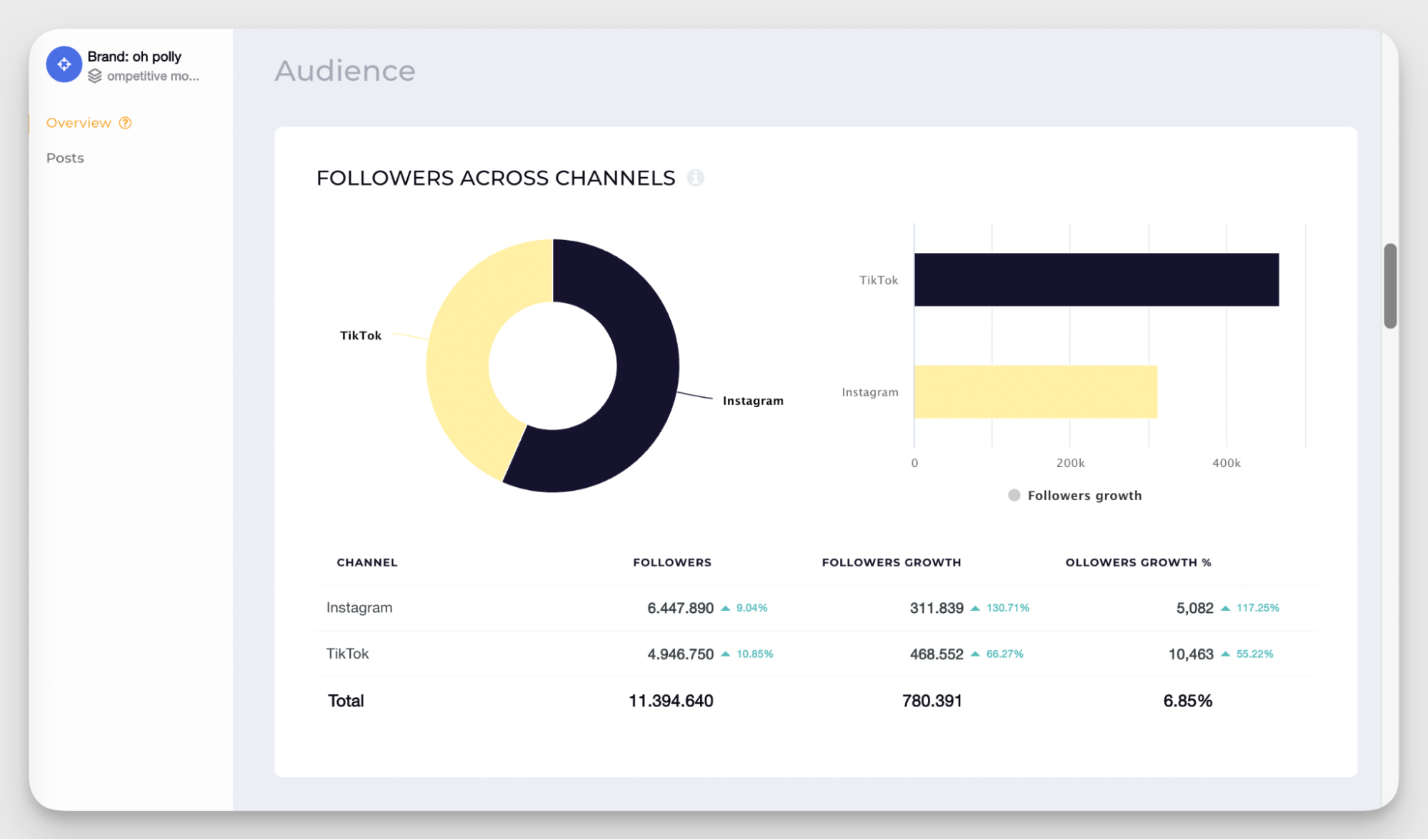
When Odd Muse compares their audiences, they can see the two brands have had similar results.
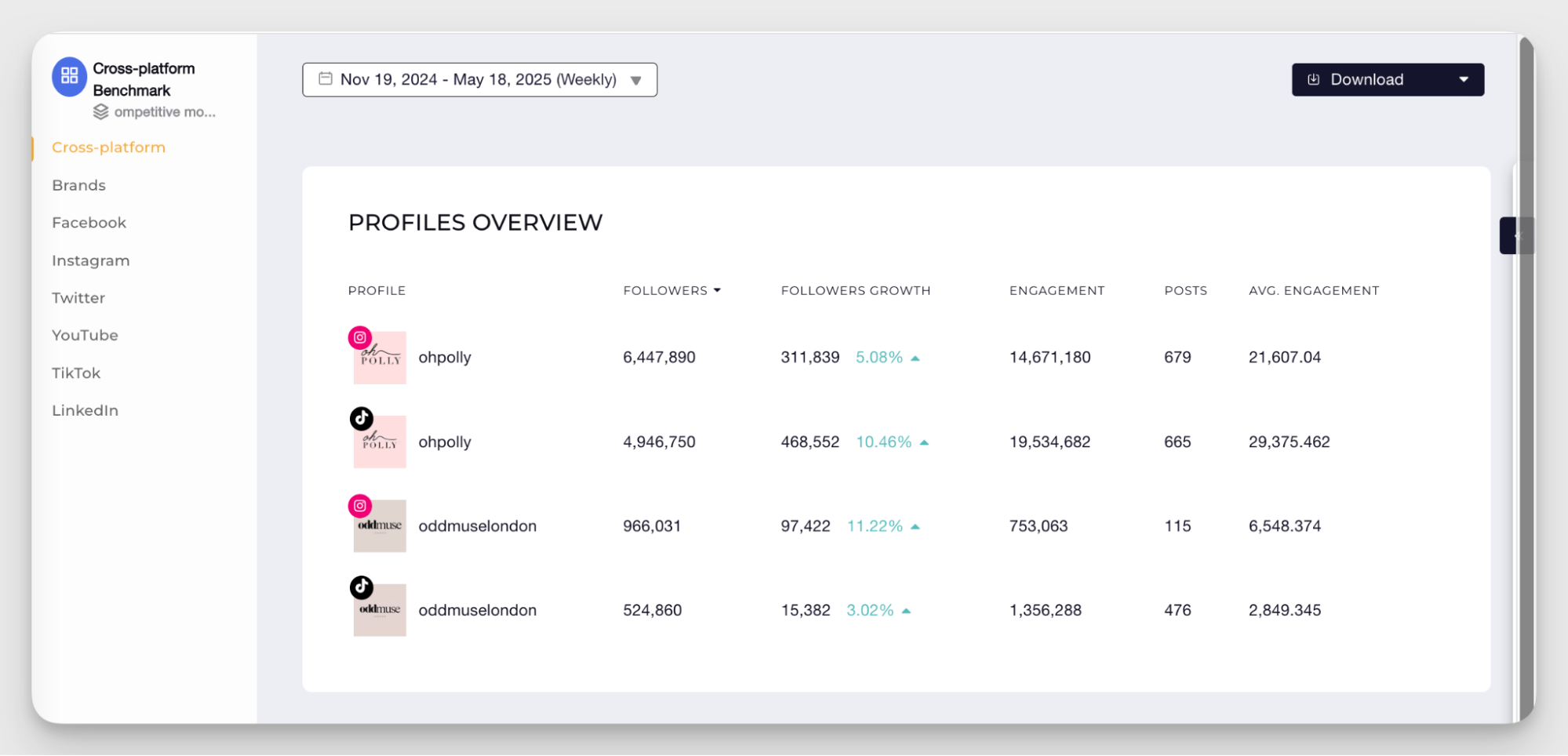
However, platform focus matters. For example, if Odd Muse’s main focus is increasing its follower base on Instagram, they’ve got a higher percentage increase than Oh Polly, meaning they have a better strategy for that specific purpose.
My competitive monitoring process has become significantly more efficient since I started using Socialinsider. One of the things I appreciate most is how convenient it is to have all the key social media platforms—LinkedIn, Facebook, Instagram, and TikTok—available in one place. I don’t need to switch between multiple tools or manually collect data from different sources. Everything I need is in one dashboard.
This centralized access allows me to easily compare competitors’ performance across platforms, spot trends, and identify content strategies that are working well for them. I particularly value the level of detail the platform provides—it goes beyond basic metrics and gives deeper insights into engagement, content types, posting frequency, and audience behavior. Elene Fanchulidze
Analyzing content themes and messaging evolution
It’s also important to pay attention to competitor content pillars, analyzing what they tend to post about and how they put out their messaging.
With Socialinsider, for example, Odd Muse can easily monitor the content pillars spread across Instagram and TikTok for both brands, alongside the impact generated.
Below, we can dive into Odd Muse’s top content pillars across both channels, the number of posts they share from each pillar, engagement data, and which channel each pillar performs best on.
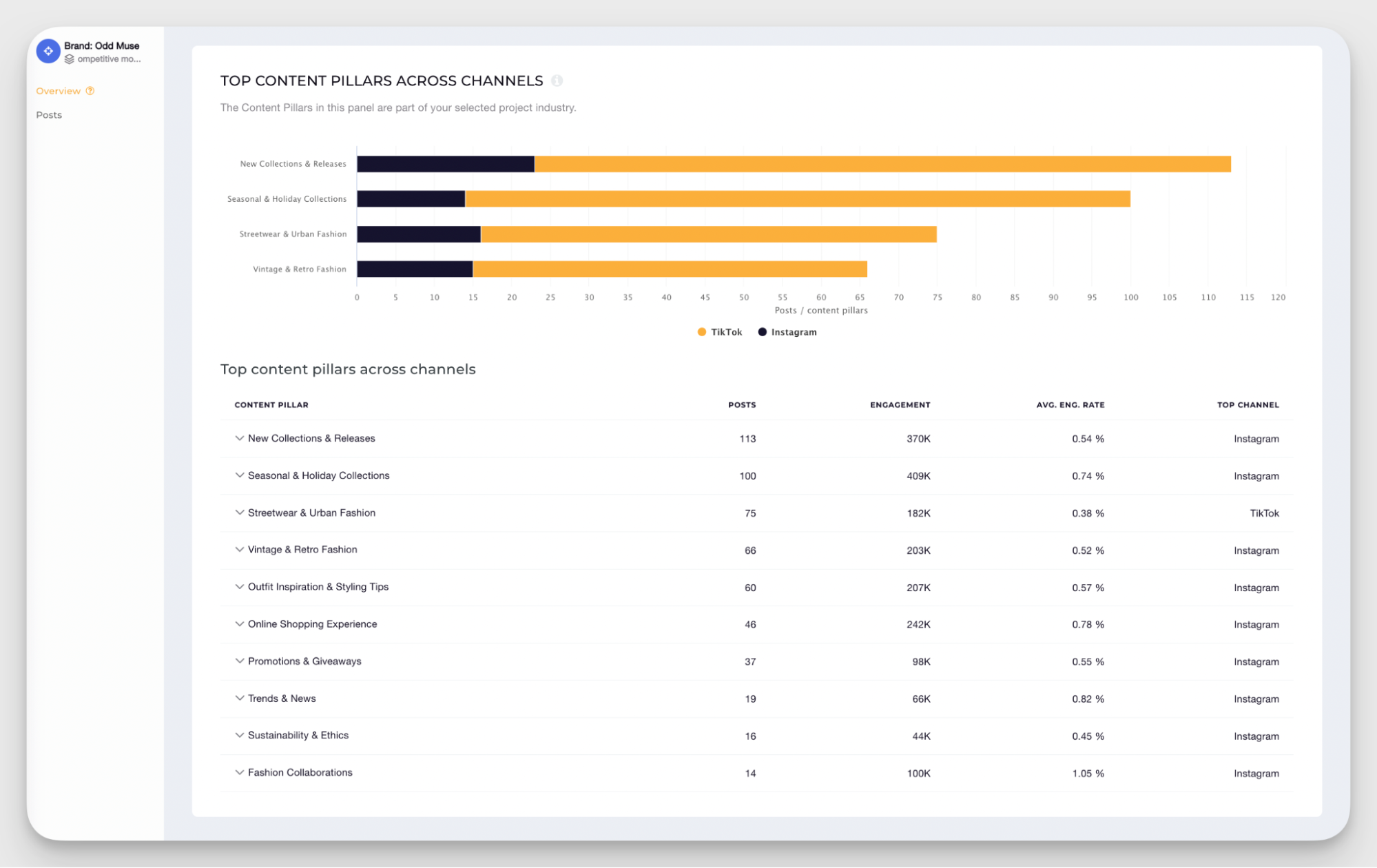
And below, we see the same dashboard for Oh Polly’s content.
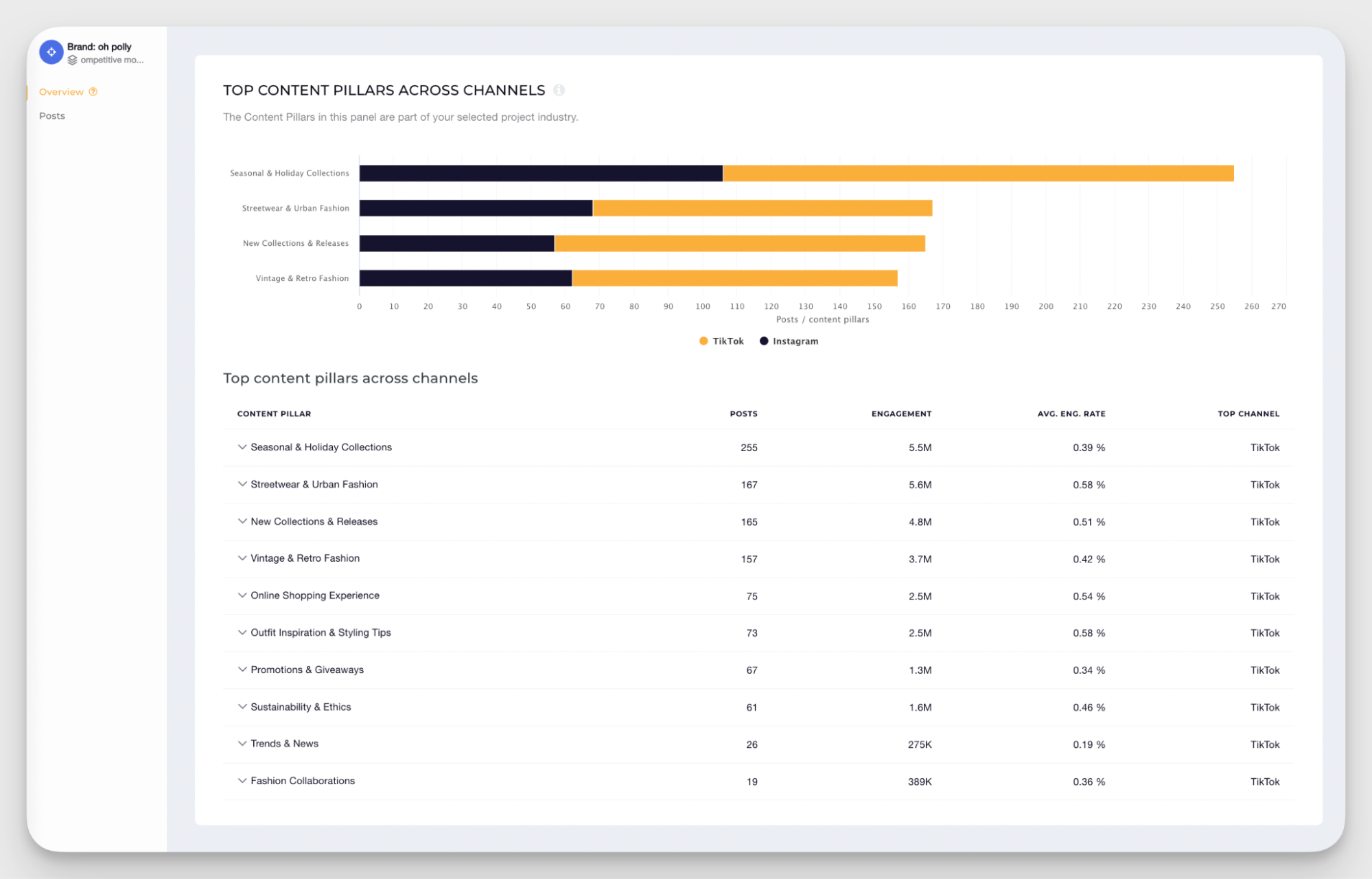
Looking at content themes can help you make sure you’re posting the right types of content for your audience, while also gaining inspiration for topics to post about from your competitors.
Tracking paid social campaigns and audience targeting
You also want to keep tabs on your competitors and their social media advertising strategies. You can use ad spy tools like BigSpy that give you insights into the platforms your competitors use for digital advertising, who their target audience is, and what their ads look like.
Some platforms, like TikTok and LinkedIn, also have ads libraries you can browse through to see the ads that have run on their platforms.
Monitoring engagement metrics and community management approaches
Finally, you want to make sure that you’re keeping an eye on your competitors’ social media performance, and that includes monitoring their engagement metrics and looking at how they manage their communities.
Going back to our brand examples, we can use Socialinsider to monitor engagement metrics across channels so that Odd Muse can compare how Oh Polly’s content is performing compared to their own.
The dashboard below shows us Oh Polly’s Instagram and TikTok engagement data.
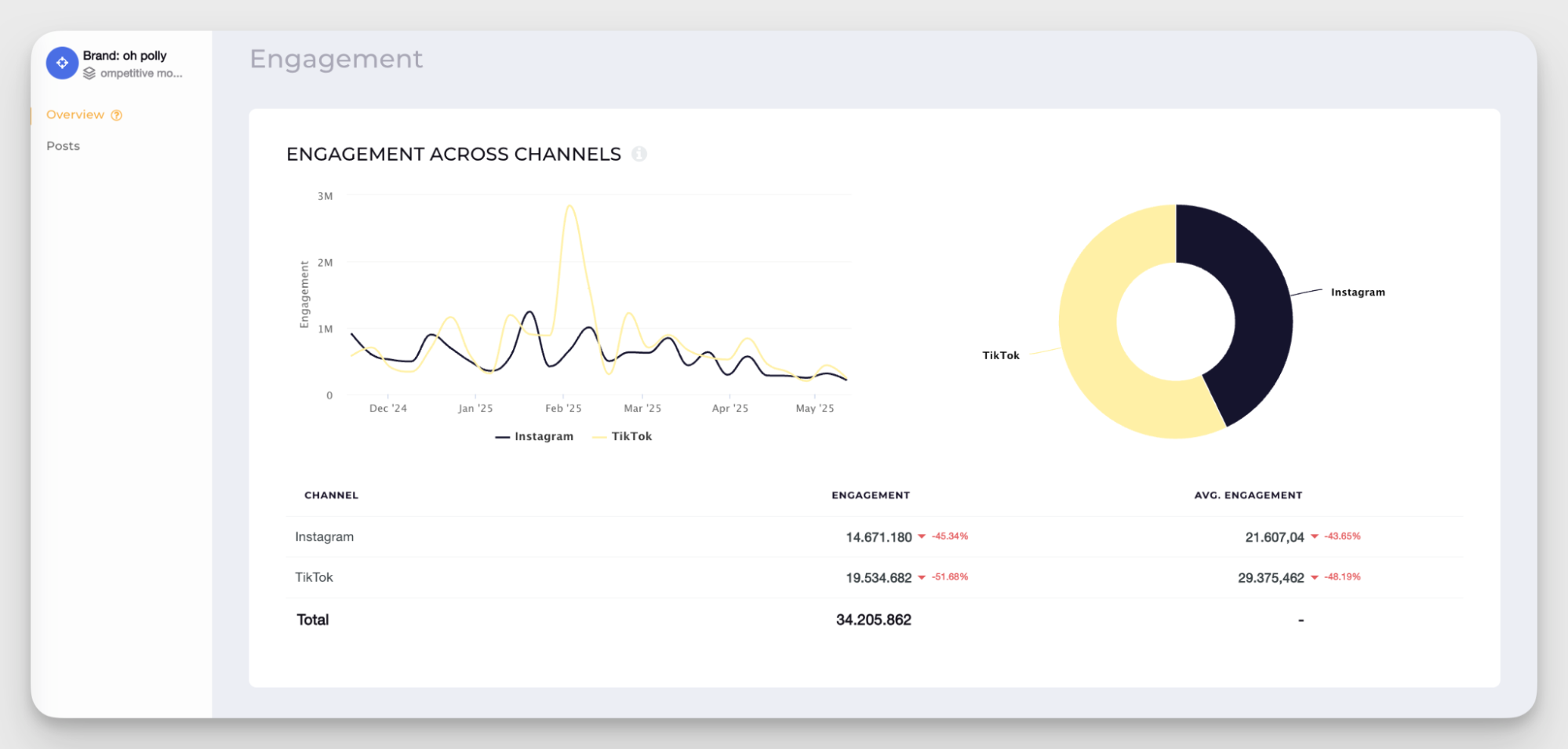
But you can also look at the brand overview to see key metrics for each competitor, like in the example below.

Customer perception monitoring
The next strategy you want to implement is monitoring your competitors’ customer perception and overall brand sentiment from your mutual target audience. How do your competitors’ customers feel about their company? And how can you use that sentiment analysis to your advantage?
Systematically tracking online reviews across platforms
Start by tracking your competitors’ online reviews on platforms like Google, G2, Yelp, and the like. Competitive intelligence tools like Klue can help you easily gather insights from customer reviews without having to manually navigate through hundreds of reviews to understand customer perception.
Monitoring forum discussions and community feedback
Check forums like Quora, Reddit, and industry-specific platforms that can give you further insight into how industry people and customers feel about each competitor. Platforms like Reddit might even have subforums specific to your industry or your competitor so that you can easily get insights from users.
Sentiment analysis techniques for customer opinion tracking
Sentiment analysis tools like Mention can help you gather customer opinions about your own brand, your competitors, as well as your industry as a whole. Track insights and look for trends amongst customer opinions to see if you need to address potential unrest in your audience.
Identifying emerging customer pain points in competitor experiences
Pay attention to online conversations and reviews that mention products or features that your competitors may be missing or other major pain points your competitors’ customers may be mentioning. If you can solve pain points that your competitors are causing, you’ll be able to shift their customers over towards your business.
Brand messaging and positioning monitoring
Monitoring your competitors’ brand messaging and positioning can give you a heads up when they appear to be making a pivot, teasing a new feature, or adding another facet to their target audience.
When you consistently monitor positioning, you’ve got the upper hand as you can quickly respond with your own positioning adjustments to make sure you stand out.
Tracking messaging evolution and positioning shifts
Watch as your competitors start evolving or shifting their positioning in the market. They could be getting ready to launch a new product or feature, and you want to be aware of that fact as quickly as you can.
Identifying new value propositions and target audiences
When you monitor your competitors’ overall messaging, you can start to pinpoint value propositions and target audiences that they’re hitting that your strategy might be missing. This can be a great way to expand your own messaging and start reaching new potential customers.
Monitoring communication channels and preferred platforms
Part of this is also looking at the different channels the other brands in your industry use to promote themselves. Discover new platforms your audience prefers so you can add yet another way to reach them to your own strategy.
Promotional and pricing strategy monitoring
Competitive monitoring can also include tracking the different promotional and pricing strategies across your industry. Look at how different brands are using sales and discounts to sell their products, as well as what their overall pricing looks like so that you can stay competitive.
Techniques for tracking pricing changes
Tools like Visualping can make it easy to monitor pricing changes across your industry. Tracking these changes can let you know where your prices sit on the spectrum, as well as if you need to consider lowering or raising your prices based on competitor costs.
Identifying patterns in promotional timing
This tracking strategy can also help you discover when other brands in your industry tend to run promotions. Once you start identifying patterns, consider putting together a plan so you can take advantage of certain industry promotional events while also setting up your own.
Monitoring discount strategies and loyalty program adjustments
Pay attention to the different discounts that brands in your industry offer and consider if you can offer similar sales while still making a profit. You can also use this time to monitor your competitors’ loyalty programs, figuring out how they work, tracking changes over time, and putting together your own program that your target customers will enjoy.
Product and feature development monitoring
Implementing a strategy that helps you monitor competitor product and feature updates can help you get new product and feature ideas and start development more quickly. Use these tactics to help build out that strategy.
Tracking product launches and updates
Set alerts so you can track product launches and updates across their website, social media, press releases, and more. You want to be instantly alerted anytime a competitor launches a new product or feature so that you can respond accordingly.
Monitoring release schedules and development priorities
As you continue to monitor product and feature releases, you may start to notice a pattern or schedule. You can then track updates more easily and start creating your own schedule of launches.
Analyzing customer feedback on new competitor features
Look at reviews and online conversations to monitor sentiment around new competitor launches. This can be a great way to determine whether their new product or feature release is something your business should consider as well.
Market expansion and channel strategy monitoring
You also want to know when your competitors are looking to expand into new markets. This can be a great way to discover new opportunities for your own business.
Tracking new market entry signals
New market entry is when a business introduces a product to a new vertical, like a new geographic area or demographic of people. Tracking these market entries can help you find new opportunities after first scoping out how your competitors do.
Monitoring distribution channel development
A distribution channel is a channel where companies sell goods or services to their customers. Keeping an eye on your competitors’ distribution channels can help you get an early alert if they’re introducing a new sales channel, which is a signal for you to investigate if you should test new channels as well.
Identifying partnership and alliance formations
Partnering with complementary businesses can be a great way to cross-promote products to wider audiences. Track your competitors’ partnership formations to get inspiration for building your own partnerships and collaborations.
Organizational change monitoring
Lastly, it’s also important to monitor organizational changes like new C-Suite members, acquisitions, and the like as these can have major impacts on your competitors and the industry as a whole.
Tracking key leadership changes
Start by tracking key leadership updates, like a new CEO or other C-Suite executive. This can let you know if your competitors may be going through major changes, but it can also alert you to potential new hires within your own organization.
Identifying structural reorganizations and strategic pivots
You also want to monitor for any structural reorganizations in your competitor companies as it may suggest a shift to an entirely different market or a major expansion within your own market. This can let you know if you don’t need to consider a company a competitor anymore or if a company appears to be aligning itself even closer to your business.
Final thoughts
Staying ahead in a competitive market means keeping a close eye on every move your competitors make. From website updates to social media shifts and product launches, continuous monitoring helps you react faster, plan smarter, and uncover opportunities your competitors haven’t yet seen.
FAQs on competitive monitoring
How to present monitoring findings to different stakeholders?
These eight strategies can help you find key competitor updates that you can then respond to in your own way, whether that’s by emulating their releases or strategic shifts, or by making your own pivots.
Put together reports so you can share your findings with the stakeholders who need to make those decisions. Take advantage of Socialinsider to compile your social media intelligence into a visually appealing and easy-to-understand report.
Analyze your competitors in seconds
Track & analyze your competitors and get top social media metrics and more!
You might also like
Improve your social media strategy with Socialinsider!
Use in-depth data to measure your social accounts’ performance, analyze competitors, and gain insights to improve your strategy.



